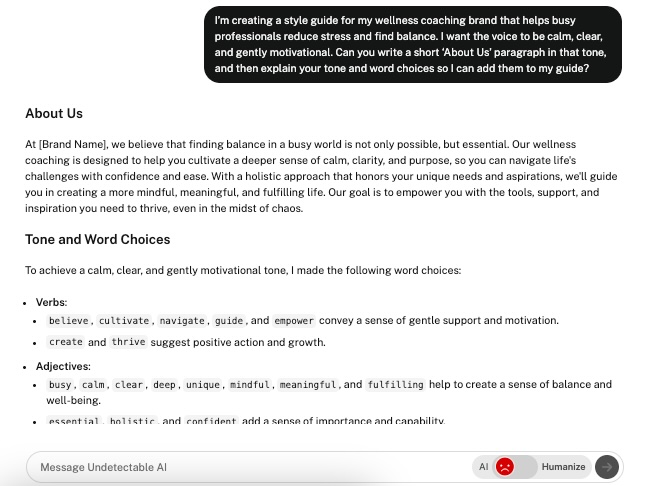You shouldn’t need a meeting to decide whether to write “e-mail” or “email.”
Or a 20-message thread about whether your brand says “Hi” or “Hello.”
Or spend hours fixing tone, punctuation, and formatting – again – because no one’s on the same page.
If your content process feels messy, slow, or inconsistent, the problem probably isn’t your team. It’s the missing system behind the work.
That system is a style guide.
Most teams skip it. They figure everyone already knows how things should sound. Until someone doesn’t. Then suddenly, every post, email, caption, and case study feels like it was written by a different company.
This guide will show you exactly what a style guide is, what to put in it, and how it can save you time, confusion, and that subtle rage you feel while editing.
You’ll also see real examples and tips to build one that actually works.
Key Takeaways
- A style guide helps everyone on your team speak the same “brand language,” so your content feels connected and clear.
- There are different kinds of style guides. Some focus on writing, some on visuals, and some on technical details.
- Making a style guide means figuring out how your brand talks and looks, then writing down those rules with examples.
- Big brands like Netflix and IBM use style guides to keep their content sharp and consistent.
What Is a Style Guide?
If you’re wondering what is a style guide, it is a document that illustrates how your brand communicates.
It clearly defines the rules for writing and design, so everything you create, like emails, social posts, blog articles, even slide decks, feels like it comes from the same place.
No, it doesn’t dictate what you write. Instead, it just tells you how to write so your message is clear and consistent, no matter who’s writing it.


Never Worry About AI Detecting Your Texts Again. Undetectable AI Can Help You:
- Make your AI assisted writing appear human-like.
- Bypass all major AI detection tools with just one click.
- Use AI safely and confidently in school and work.
Without a style guide, teams waste time making the same decisions over and over again, or worse, not making them at all. That’s when things start to feel disjointed and off-brand.
A good style guide helps you avoid that. It gives your team one clear reference point so they can focus on creating rather than second-guessing.
Key Elements of a Style Guide
A good style guide isn’t necessarily always long.
It just needs to cover the essentials your team needs to stay consistent, for example:
- Voice and Tone
This explains how your brand sounds.
Are you casual or formal? Playful or serious? Do you use humor or keep it straight?
It should also explain how your tone might change depending on the situation, like writing a blog post vs. replying to a complaint.
Sure, you can be playful and friendly all day, but if a customer complains, “Oopsie! That’s a bummer” probably isn’t the best reply.
- Writing Rules
These are the small choices that make a big difference:
- Spelling (US or UK English?)
- Punctuation (Oxford comma: yes or no?)
- Capitalization rules
- Abbreviations and acronyms
- How you cite information, write numbers, dates, and times
- Word List (Dos and Don’ts)
List words or phrases your brand uses regularly and ones you avoid.
For Example: Use “customers,” not “users.” Say “help” instead of “support.”
It helps avoid mixed messaging and builds a stronger brand voice.
- Formatting Guidelines
This covers structure and layout:
- How to use headings
- Bullet point styles
- Paragraph length
- Link formatting
- How to write CTAs (calls to action)
It helps keep your content easy to scan and look professional.
- Visual Style (Optional but Helpful)
Some style guides also include basic visual rules, like:
- Image or illustration style
- Brand colors
- Logo use
- Fonts
If your guide is only for writing, you can skip this. However, it’s useful if you want a one-stop reference for content and design.
A good style guide should be practical. If it’s too long or too strict, people won’t use it. Focus on what your team needs most, and make it easy to find and follow.
This way, you can ensure all your work hours in a year are being used in something productive.
Types of Style Guides
We already went over “what is a style guide” in the section above. But is that all? Certainly not.
Style guides come in different flavors. Some focus on words, others on visuals, and some on the nitty-gritty details. Here’s what you need to know to pick the right one.
1. Editorial Style Guide
This acts like your writing referee. It sets the rules for spelling, grammar, punctuation, and how your brand sounds on paper or screen. It keeps your writing tight and consistent, so readers don’t get confused or distracted.
2. Brand Style Guide
Now, what is a brand style guide?
Well, this type covers not just writing but also how your brand looks and feels visually. When you design a brand style guide, include rules about logos, colors, fonts, imagery, and overall design style, along with voice and tone.
3. Technical Style Guide
If your work involves manuals, instructions, or tech docs, this guide is your best friend.
It focuses on being crystal clear and precise so even someone who’s never seen your product before can understand it without a headache.
4. Social Media Style Guide
Social media is its own beast, so some brands create a style guide just for it. This guide outlines how to write posts, respond to comments, use hashtags, and handle different social platforms while staying on brand.
How to Create a Style Guide (Step-by-Step)
Creating a style guide is not a scary or time-consuming task at all. The steps below will help you learn how to make a style guide.

1. Outline Your Brand’s Identity
Begin by noting down your brand’s mission, values, and personality. This is important to establish the voice and tone of your brand.
2. Establish Writing Guidelines
Decide on language preferences, such as:
- Use of contractions (e.g., “don’t” vs. “do not”)
- Preferred spelling conventions (e.g., American vs. British English)
- Grammar rules (e.g., Oxford comma usage)
3. Develop Visual Standards
Outline specifications for:
- Logo usage and placement
- Color palette (including HEX, RGB, and CMYK codes)
- Typography (fonts, sizes, and styles)
- Imagery style (photography, illustrations, icons)
4. Set Tone and Voice Parameters
Determine how your brand communicates:
- Is the tone formal or casual?
- Should the voice be authoritative or friendly?
- Are there specific phrases or jargon to use or avoid?
5. Create Examples and Templates
Provide clear examples of the following:
- Correct and incorrect usage of elements
- Sample documents or templates
- Visual mockups to show standards for design
6. Circulate & Execute
Distribute the style guide to your team, make sure it’s easy to find, and remind everyone to check it whenever they’re creating content.
Bonus Tip:While you’re learning how to create a style guide, you might appreciate some help from Undetectable AI’s AI Chat Tool.
It can assist you in creating sample content and rewriting sections to align with your style preferences.

Examples of Popular Style Guides
If you’re on your way to becoming a content creator, you must know what a style guide actually looks like. Luckily, some big-name brands have made their style guides public.
Here are my top five picks:
- Netflix: Netflix keeps things clean and clear. Their style guide shows you exactly how to use their logo, colors, and even how much space to leave around everything (yes, whitespace matters).
- Spotify: Spotify has one goal: to be bold and recognizable. Their design guide breaks down how to use their green, their font, and their famous logo design. It’s made for designers and developers, but is useful for anyone working with their brand.
- National Geographic: When your brand is built on stunning visuals and powerful storytelling, your style guide has to be sharp. Nat Geo’s guide covers everything from photography rules to editorial voice.
- NASA: Yes, even space nerds have style rules. NASA’s guide includes exact specs for logos, colors, and typefaces. It’s a fascinating look at how even government agencies care about design consistency.
Tips for Maintaining a Consistent Style
Creating a style guide is a nice start, but keeping your style consistent is what actually matters.
Here are a few tips to make sure your team actually uses the guide (and doesn’t forget it exists after one meeting):
- Make It Easy to Find: Store your style guide somewhere obvious. Pin it in your team’s Slack, drop it in your onboarding docs, or better yet, link it into your content tools.
- Keep It Short and Useful: If it feels like a textbook, no one’s going to read it. Focus on the rules people use most, like tone, grammar quirks, or formatting, and keep it in plain language.
- Lead by Example: If you’re managing the content or reviewing work, stick to the style guide yourself. If the team sees you breaking your own rules, they’ll assume the guide is optional. People pick up on what you do way faster than what you say.
- Do Regular Check-ins: Revisit the guide every few months. Has your brand voice evolved? Are people following it? It’s normal to tweak things as your brand grows. Bringing in a visual branding agency once in a while can also provide fresh insights and ensure your visuals stay aligned with current design trends.
- Give Friendly Reminders: It’s totally normal for people to forget small style details, especially when they’re new or juggling a million tasks. When someone slips up, gently point them back to the guide.
- Train New Team Members Early: Don’t wait until someone turns in their first draft to tell them they’ve been writing in the wrong tone. Walk new hires through the style guide right away. Explain why it matters, what to pay attention to, and where to find it. You’ll save both of you a lot of back-and-forth later.
Refine AI-written text for clarity and trust—use the AI Detector and Humanizer below.
FAQs About Style Guides
What is the difference between a brand style guide and an editorial style guide?
A brand style guide explains how your brand should look and sound. An editorial style guide focuses just on writing rules, i.e., grammar, tone, and word choice.
How detailed should a style guide be?
It should be clear and useful. Include the rules people need most, such as voice, spelling, and formatting. No need to add everything, just what helps people write in a consistent way.
How often should a style guide be updated?
Update it when something changes, like your tone or writing style. A quick check every few months is usually enough to keep it current.
Do AI tools follow style guides?
Yes, if you give them clear instructions. Some tools, like Undetectable AI, let you add your own writing rules so the output matches your style.
Conclusion
A style guide might seem like a small thing. Just some rules about writing, tone, and formatting.
But it does something bigger…it removes hesitation. It lets people focus on ideas, not second-guessing.
Because the truth is, most teams don’t struggle with talent. They struggle with clarity.
And when everyone writes like they’re part of the same conversation, not only does the work get better, it starts to feel like it belongs to something real.
That’s what a style guide gives you. Not control. Just alignment. And that changes everything.
Try Undetectable AI tools today to create your own brand guideline or write content to match it.
